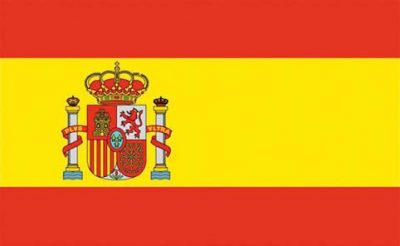
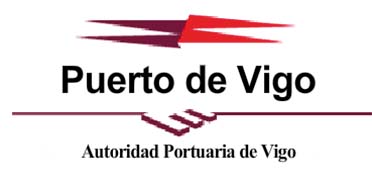 The Ria de Vigo is one of the best natural harbours in the world, and is protected by the offshore Islas Cies with their jagged peaks. This ria is one of four rias in the area, with the Ria de Pontevedra the next ria to the north with a large Spanish Navy training base at Pontevedra, which is the capital of this part of Galicia. The rias are sometimes, misleading, compared to fjords. They cannot be compared to the grandeur of a stormy Norwegian fjord, as the surrounding hills are lower in height, and visually more serene, with cultivated crops down to the edge of the sea. Galicians love their Rias Bajas (Deep Rias), whether they have big cities like Vigo or whether they have been hardly touched by mankind.
The Ria de Vigo is one of the best natural harbours in the world, and is protected by the offshore Islas Cies with their jagged peaks. This ria is one of four rias in the area, with the Ria de Pontevedra the next ria to the north with a large Spanish Navy training base at Pontevedra, which is the capital of this part of Galicia. The rias are sometimes, misleading, compared to fjords. They cannot be compared to the grandeur of a stormy Norwegian fjord, as the surrounding hills are lower in height, and visually more serene, with cultivated crops down to the edge of the sea. Galicians love their Rias Bajas (Deep Rias), whether they have big cities like Vigo or whether they have been hardly touched by mankind.
The Port of Vigo is arrayed along the southern shoreline of the ria, with superb views of the bay and the surrounding green forest ridges. Vigo has a population of almost 300,000 and became the first Galician town to industrialise with the opening of several sardine canneries. It is now the chief fishing port of Spain with fish wharves stretching five kilometres along the shore. The original port was at Baiona (Bayona) and closer to the mouth of the ria until the arrival of the railways and the necessity of more protection from Atlantic storms. It was to Bayona on 10th March 1493 that the Pinta carrying Colon (Christopher Columbus) returned after his first voyage of exploration with the news that the New World had been discovered.
At the turn of the century in 1900 and subsequently, Spanish liners docked at the Estacion Maritima del Ria to embark generations of Spanish and Portuguese emigrants in large numbers seeking a new life in the Americas. Today, big cruise ships dock at the same berth with their visitors keen to see the sights of Vigo city, and well as the surrounding countryside, and to sample the excellent restaurants and superb tapas bars of El Berbes, the name for Old Vigo. Fresh fish is sold on the Rua de Pescaderia from the many trawlers unloading their catches every day. The cruise ship terminal is almost adjacent to the long Puerto Pesquero (Fish Port) of 1,400 feet in length in a central location on the Vigo waterfront, with the ro-ro terminal (Ensenada de Bouzas) to the south and the container terminal to the north.
History Of Vigo
The name of Vigo is derived from the Roman settlement of Vicus Spacorum, and ancient Phoenician and Greek seafarers also lived here. The twelfth century troubadour and poet Martin Codax and his friends waxed lyrical about the ria where their lovers bathed in the nude. Sir Francis Drake sacked the town twice in 1585 and 1589, and later in 1702 the English fleet surprised a joint Spanish and French treasure fleet of laden galleons returning from the Caribbean and destroyed eleven of them in the Battle of Vigo or Battle of Rande. The population grew rapidly due to the big fishing industry from 6,700 in 1842, to 23,200 in 1900, 137,873 in 1950, and now stands at 295,500 people. The huge fish market befitting the premier fish port in Spain down in the cobbled streets of El Berbes starts early at dawn from 0400 hours in summer with fish dealers vying with each other to purchase the best of the many types of Atlantic fish, together with oysters grown locally in the ria. Vigo lies within twenty miles of the Portuguese border to the south and the Rio Minho, where Spanish tramps were anchored as prison ships holding captured Republican troops and political prisoners at the end of the Spanish Civil War won by Franco and the Nationalists in 1939.
Bayona is a historical jewel and a resort of some note ten miles down the ria from Vigo, and is topped by the walls of the medieval Castillo de Monterreal on a hill above the estuary. The walls are the only part of this huge castle to survive, with the destroyed interior replaced by a charming parador, one of the Spanish national hotels, with many luxuries to offer the traveller. If one is not staying at the parador, the small entrance fee to tour the grounds and walls of the castle is well worthwhile. Further inland from Bayona and its parador are many dolmen stones from ancient Celtic civilisations, and large ranches where Gallego (Galician) cowboys round up their cattle as well as the wild horses in Spring that roam the area. I have sampled Gallego meat and fish dishes in Gallego restaurants, served by proud Gallego waiters, and found the dishes to be excellent if a trifle expensive.
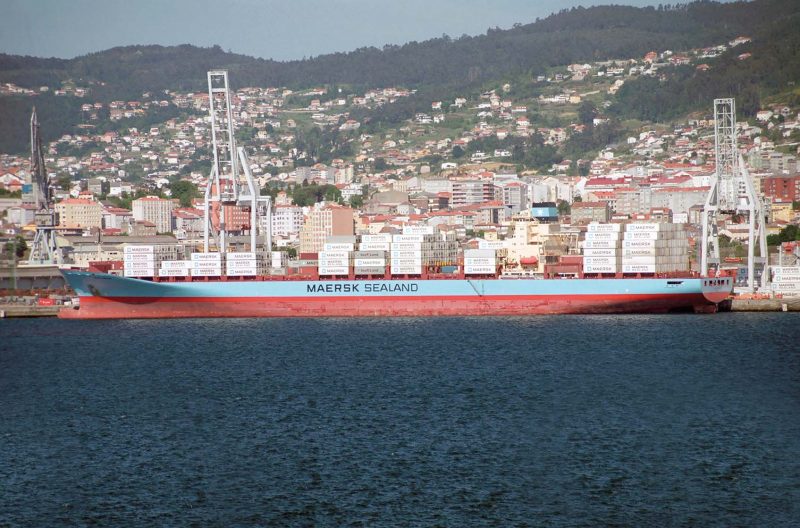
The Estacion Maritima de Trasatlanticos saw passenger ships from many countries calling, including Trasatlantica Espanola, Fabre Line, French Line, Messageries Maritimes, Royal Mail Lines and Hapag of Hamburg. The passenger liner Hammonia of Hapag called at Vigo in early September 1922 for emigrants, and sailed for Puerto Mexico (Coatzacoalcos) on 9th September. She sent out a distress radio message later that day that she had hit an unidentified submerged object seventy miles west of the port and was sinking. She had a bad list and was leaking through her coaling ports, but fortunately most of her passengers and crew were taken off by Soldier Prince of Prince Line and Kinfauns Castle of Union Castle Line with the loss of nineteen lives. She sank the next day only six months after Hapag had purchased the liner as Hollandia from Royal Holland Lloyd. She was of 7,291 grt, length of 128 metres and beam of 16.5 metres, twin screw and powered by twin triple expansion steam engines, and had been completed in April 1909 by the Alexander Stephen yard at Linthouse on the Clyde. She had accommodation for 80 passengers in First Class, 116 in Second Class, and 1,000 passengers in steerage down in the holds.
A new passenger reception terminal on the Estacion Maritima de Trasatlanticos was opened on 27th May 1966 as the Las Galerias de Transito. This long two storey concrete terminal of length 375 metres was built by the local construction firm of Manuel Perez Pineiro, which was awarded the contract in December 1963. Many large liners called included Canberra of P. & O., the QE2 of Cunard Line, and Ellinis and Britanis of Chandris Lines, but after 25 years in use the terminal was demolished in 1989, and the current new modern cruise liner terminal was then completed on the same site. Vigo harbour tugs assisted these famous liners, and harbour craft owned by the Junta de Obras del Puerto de Vigo maintained the port facilities such as Rias Bayas and Jose Elduayen.
Port Traffic
Total port traffic in 2015 amounted to 4.05 million tonnes with 224,000 TEU of containers passing through the port. General cargo made up 3.468 million tonnes, with dry bulk cargo and scrap metal of 368,000 tonnes, liquid bulk of 69,580 tonnes, Galician export granite of 224,000 tonnes, and cement of 288,000 tonnes. Vigo has the biggest granite tonnage exported in Spain. New vehicles exported at the ro-ro berth amounted to 598,742 together with 10,865 trailers and lorries. Fresh and frozen fish are totalled separately from general cargo due to the very large catches and amounted to 600,797 tonnes of frozen fish and 778,632 tonnes of fresh fish, or 60% of the total Spanish catch. A total of 82 cruise ships called at the twin berths of the Estacion Maritima del Ria carrying 205,000 passengers.
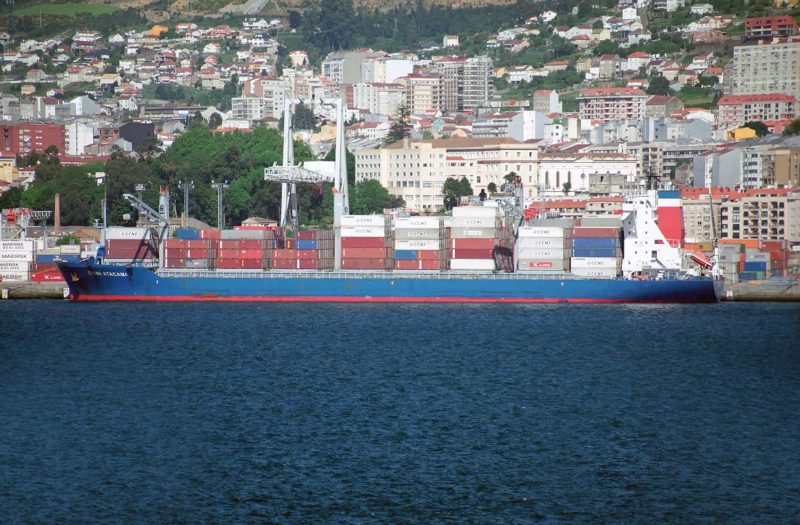
The port has four berths and five ramps for ro-ros at Bouzas for the export of half a million cars per year from the Puegeot Citroen factory in Vigo in Wallenius Wilhelmsen car carriers. Vigo is the second largest Spanish port for the export of new vehicles, 82% of Peugeot Citroen factory output being exported. The Suardiaz Terminal Bouzas has vehicle storage areas of 350,000 square metres and is only three minutes from the Peugeot Citroen factory. The terminal uses all types of lifting equipment, spreaders, flats and stowage suitable for the needs of each heavy lift load e.g. locomotives, railway carriages and long loads. The terminal is used by the eight ro-ro car carriers of the Lineas Suardiaz fleet, including Suar Vigo, Bouzas and Galicia.
There is one long container berth with four gantry cranes to the north of the cruise terminals at Guixar. There is also the El Berbes Fish Quay (Puerto Pesquero) of extended length just downstream from the cruise terminal, the Arenal Quay, the El Tingalo del Puerto quay, and other smaller quays in the central part of the port. Unusual cargo unloaded in recent years from gantry crane bulk carriers and heavy lift ships has been the very tall cylindrical masts and big diameter blades of the imported wind turbines, as Galicia is an extremely windy province but useful for eco friendly renewable electricity generation. Regular Sirius Cement ships call fortnightly from Carboneras, a Spanish Mediterranean port, and Navigasa vessels call with scrap metal from Santander and Algeciras. Harbour towage is provided by Remolcanosa of Vigo (Remolcadores Nosa Terra S.A.) with eight harbour tugs of up to 587 grt named Remolcanosa Uno, Remolcanosa Dos, Remolcanosa Tres, Remolcanosa Cinco, Ria de Vigo, Serra de Santiago, Pau da Luz and Don Ilde, the latter being the doyen of the fleet as she was completed in 1958.
Port Statistics
Port Authority Autoridad Portuario de Vigo
Port Location 42º14’North, 8º44’ West
Max. Vessel Size 150 metres length
Mean Tide 3.0 metres
Channel Depth 24.4 metres
Anchorage Depth 24.4 metres
Cargo Ship Calls 40.4%
Fishing Vessel Calls 35.3%
Cruise Ship Calls 9.2%

Offshore Vessel Calls 5.2%
Tanker Calls 5.0%
Ro-Ro Calls 4.9%
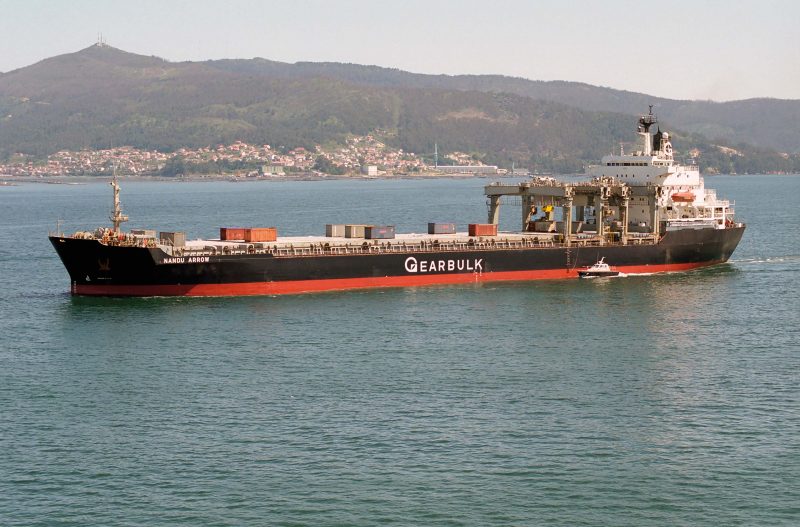
Cruise Ship Calls
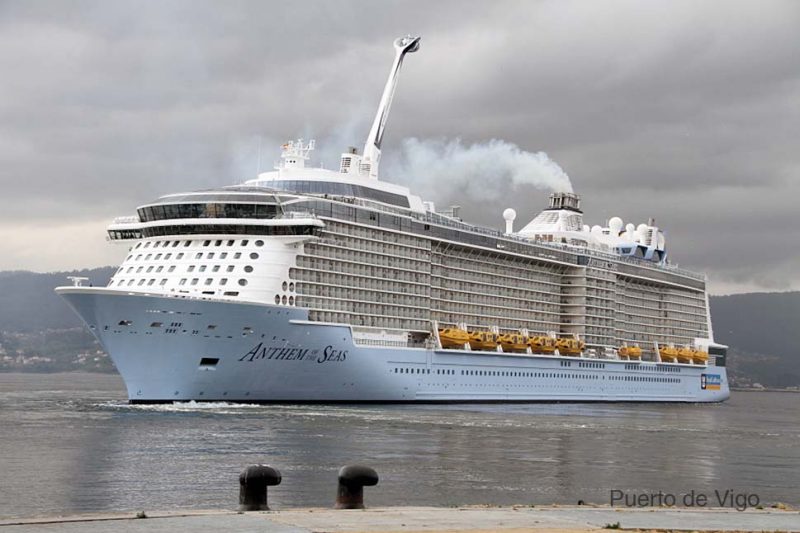
The biggest cruise liner in the world at the time, Anthem of the Seas at 167,800 grt with accommodation for 4,905 passengers on sixteen passenger decks, called for the first time at Vigo on her maiden voyage at the beginning of May 2015, and made two subsequent calls later in 2015. She is the second vessel of the Quantum of the Seas class, the lead ship being completed in 2014. This giant pair of cruise ships has a remarkable ‘North Star’ aerial glass observation capsule that takes passengers almost three hundred feet into the air above the ocean and looking down over the side of their hulls. Royal Caribbean International, their owners, make a dozen calls per year at Vigo, and other cruise lines calling include P. & O. Cruises, Cunard Line, Fred. Olsen Cruises, Windstar Cruises, Holland America Line, MSC Cruises, Costa Crociere, Silversea Cruises, Hapag Lloyd Cruises, Phoenix Seereisen, NYK Yusen Cruises, Sea Cloud Cruises, V Ships Leisure and Apex Cruises. Cruise ship passengers disembark to see the sights of Vigo that include the palaces lining the Calle Real, and the great views of the ria from the Parque del Castro at the top of the city, as well as the Parque Quinones de Leon with its seventeenth century Pazo de Castrales museum. The artistic statue of four horses on a vertical framework in the Praza de Espana by Juan Jose Oliveira is another top tourist attraction.
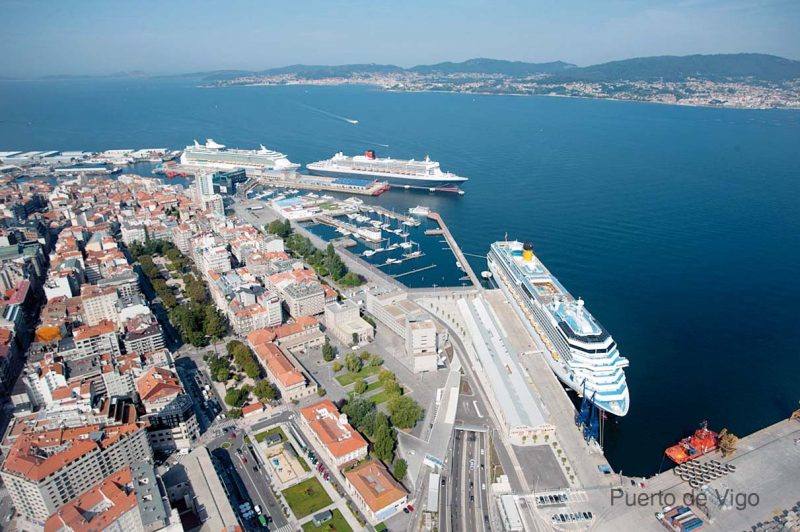
Vigo Trawler Fleets
There are 61,000 Spanish fishermen, many working for several current big Vigo trawler fleets including Pescanova S.A., Pescaberbes S.A., Pescafresca S.A., Pescabon S.A., Pescatun S.A., Pescabaqueiro S.A., Freiremar S.A. and Pescapuerta S.A. The latter was founded in 1956 when the company acquired its first trawler, and it now has fleets in ten Spanish ports with a subsidiary in Puerto Madryn in Argentina. The largest Pescapuerta fish freezer factory ships are Beagle and Capricorn of 2,800 grt, with many of the smaller trawlers having a ‘Pescapuerta’ prefix to their names e.g. Pescapuerta Primero of 445 grt built in 1971, Pescapuerta Segundo of 495 grt built in 1973, Pescapuerta Tercero of 849 grt built in 1974, Pescapuerta Cuarto of 1,627 grt built in 1983, Pescapuerta Quinto of 1,213 grt built in 1988, Pescapuerta Sexto etc. The Vigo deep sea trawlers fish worldwide, but especially on the Grand Banks to the south of Newfoundland, and the most common fish species landed are cod, haddock, Pollack, sardines (pilchards), blue whiting, skipjack tuna, yellowfin sole, yellowfin tuna, mackerel, rays, sharks, skates, turbot, sea trout, sea bass, salmon, flatfish and many other species. Visiting trawlers from Gijon, Bilbao and Huelva also land their catches at Vigo, including those of Pescavensa S.A. of Huelva, which uses the prefix ‘Pescavensa’ for its fleet e.g. Pescavensa Dieciseis of 184 grt built at Huelva in 1989.
Pescanova S.A. Fish Factory Trawlers
The fish factory freezer trawler was pioneered in the 1950s by Christian Salvesen of Leith with Fairtry, Fairtry II and Fairtry III, and later by J. Marr Trawlers of Fleetwood with Junella of 1962, in the United Kingdom, and by Pescanova S.A. in Vigo, formed in 1959. The Vigo pioneer was Jose Fernandez Lopez, who began in 1959 with side trawlers and stern trawlers such as Andrade, Doncos, Lemos, Pambre, Villalba and Condomar of one hundred metres in length, and then fished with long distance fish factory freezer trawlers in the southern hemisphere in the seas off Namibia, Mozambique, South Africa, Argentina, Brazil, and Latin America. The fish factory freezer trawlers were of over one hundred metres in length, and to avoid the long voyages home to Vigo, the Trasatlantica Espanola liner Habana, dating from 1923 when completed at Bilbao as Alfonso XIII by Sociedad Espanola de Construccion Naval, was purchased in 1962. She had been sold for breaking up at Vigo in 1960 but demolition was not started. She was renamed Galicia and converted into a fish factory with cavernous refrigerated holds for transferring the fish from trawlers off South Africa and transporting it home. She set sail in 1964 for South Africa for the first time with her attendant fleet of trawlers.
Pescanova S.A. became the biggest freezer factory trawler business in Spain and Portugal, and ensured its longevity until today by abiding by quota limits and a fishing ground rationalisation policy to protect fish stocks in one area by moving on to fish offshore from twenty different countries. The two hundred mile fishing zone around these southern countries was introduced in 1980 and was respected by the company. Pescanova S.A. owned forty freezer trawlers in 1974, the largest being of 2,715 grt and named Gondomar, Gelmirez, Mino, and Sil, but today it sells a huge tonnage of fish caught from a fleet of one hundred associated freezer trawlers owned by Spanish trawler owners, many with the prefix ‘Pescamar’ to their names followed by a number. Pescanova S.A. remains as the largest fishing company in the world, with subsidiaries in nine countries e.g. Argentina, Uruguay, Namibia, Mozam-bique, Australia, U.S.A., Japan as well as at Las Palmas de Gran Canaria and Lima in Peru.
Sales had already topped one billion dollars in 2002, when Pescanova S.A. acquired the long established Vigo trawler company of Pesquera Vasco Gallega, which had owned trawlers for over eighty years. This company began by acquiring British steam trawlers such as the Admiralty Castle class trawler Walter Burke of 275 grt built in 1917 at Middlesbrough by Smith’s Dock Co. Ltd., which became a Vigo trawler in 1924 and was renamed Toralla in 1930, and the Aberdeen built steel trawler Sarrail of 254 grt in 1927 and renamed Arosa. Toralla was still fishing from Vigo for Pesquera Vasco Gallega in 1973, when replaced by a new Toralla of 416 grt. The Pesquera Vasco Gallego fleet was a large one of thirty trawlers at this time, most having names beginning with ‘U’ e.g. the freezer fish factory trawler Urquil of 1,461 grt built in 1967. The last two trawlers in the Vasco Gallega fleet at the Millennium were Udala of 237 grt built in 1992, and Urnieta of 296 grt built in 1961.
The headquarters of the European Fisheries Control Agency is in Vigo, and the Fishing Shipowners Co-operative of Vigo publish a monthly magazine for the benefit of the Vigo fishing industry and the many Vigo trawler owners. Types of fish landed at Vigo include cod, haddock, Pollack, bream, tuna, hake, squid, octopus, blue shark, brill, skate, cuttlefish, seabass, turbot, swordfish, monkfish, mako, ling, dogfish and many other species. Vigo is also the centre of the Galician canned fish industry.
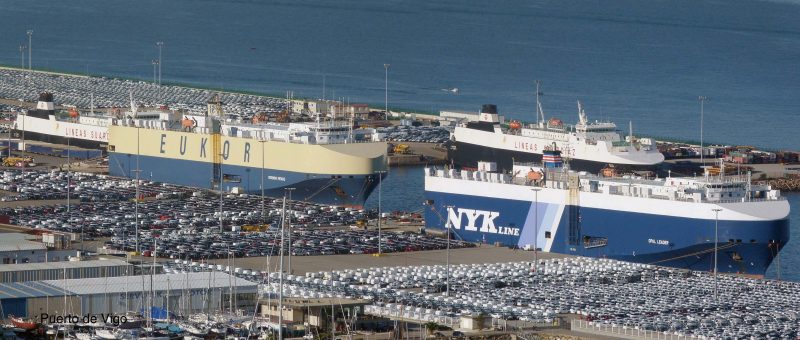
Motopesqueros De Altura Reunidos (M.A.R.)
M.A.R. (Deep Sea Motor Trawlers Collective) was founded in Vigo in 1939 by Javier Sensat Curbera and Carlos Gomez, and grew to be the biggest private fishing group in Spain with 103 trawlers and 2,400 employees. Many side, stern and fish factory freezer trawlers were built locally during the period 1950 to 1980 by yards such as Astilleros Construcciones S.A. and Hijos de J. Barreras S.A. This group of trawler owners included Javier Sensat Curbera, Carlos Gomez, Enrique Lorenzo, Antonio Alfageme, Antonio Masso, Angel de la Gandez, Eugenio Fadrique, Nicolas Pena, Isidoro Muinos and Luis Solano The common theme that bound them together was the prefix nomenclature of ‘Mar’ of their trawlers e.g. Mar Uno, Mar Dos, Mar Tres, Mar Cuatro, Mar Cinco, Mar Seis, Mar Siete, Mar Ocho, Mar Neuve, Mar Diez, Mar Onze, Mar Doce, Mar Antilles, Mar Adriatico, Mar Almeiro, Mar America, Mar Arabia, Mar Baltico, Mar Bantry, Mar Belo, Mar Blanco, Mar Cantabrico, Mar Caspio, Mar de Africa, Mar de Arabia, Mar de Banda, Mar de Barents, Mar de Escocia, Mar de Galicia, Mar de Hebridas, Mar de Irlanda, Mar de Java, Mar de la Rochelle, Mar de Labrador, Mar de los Sargazos, Mar de Mares, Mar de Vigo, Mar del Cabo, Mar del Coral, Mar del Norte, Mar del Sur, Mar Galaico, Mar Gran Sol, Mar Groenlandia, Mar Menor, Mar Mayor, Mar Muinos, Mar Mediterraneo, Mar Pequeno Sol, Mar Rojo and Mar Terranova.
General Franco opened the large M.A.R. fish processing plant at Vigo on 16th September 1955, with a large processing capacity on 7,200 square metres of factory space. The big conventional trawlers and freezer fish factory trawlers landed their catches here, including Mar de Vigo and Mar de Labrador of 2,939 grt, the latter launched on 25th March 1965 as an engines ‘midships trawler with two goalpost masts and a stern ramp. Three more freezer factory trawlers followed in Congelador Mar Uno, Congelador Mar Dos and Congelador Mar Tres of 1,400 grt built in 1973, and this large deep sea Vigo fleet fished worldwide. M.A.R. collapsed in November 1989 owing four million pesetas and threw four hundred fish processing factory workers out of work.
Vigo Shipyards
There are three shipyards in Vigo, the most well known being that of Hijos de J. Barreras, founded in 1892. Initially it built mainly trawlers and harbour tugs as well as repairing and converting small vessels. In the 1950s, the yard had seven small building berths for vessels up to 350 feet in length, powered by steam machinery up to one thousand horsepower and diesel machinery of up to 10,000 bhp built in the yard. Since the late 1960s, the yard has built up an enviable reputation for high quality vessels including passenger ferries, ro-ros, tuna and fish freezer trawlers, chemical and gas tankers, offshore vessels, cable laying and repairing vessels, cargo ships and specialised vessels.
A large workforce of loyal and contracted shipyard workers today build vessels with high technology materials and equipment. Clients include Balearia ferries running to the Balearic islands, and Armas ferries running to the islands of the Canarian archipelago. Twenty large passenger ferries were built during the decade from 1995 to 2005, the largest being Sorolla for Acciona Trasmedit-erranea of 172 metres in length and 26,916 grt completed in 2001 and carrying over two thousand passengers on routes to the Balearics and Canary Islands. The latest big ferries to be completed are Volcan del Teide and Volcan de Tinamar of 30,000 grt and a length of 175 metres with capacity for 1,500 passengers, a speed of 26 knots from diesel engines of 48,000 bhp, and in service for Armas Ferries in 2010/11. The similar Abel Matutes of 28,500 grt was followed by two offshore support ships, Edda Fides of 20,323 grt for Naviera Arnela AIE of Malta with accommodation for six hundred workers, and has one sixty tonne crane on its hull of dimensions 130 metres by 27 metres. North Sea Giant was completed with a very heavy lift crane of 400 tonnes capacity and two smaller cranes of fifty tonnes capacity.
The second Vigo yard is Freire shipyard, which has been repairing and building wooden and steel vessels since 1895 of up to 150 metres in length, mostly tugs, trawlers, oil rig support vessels, fish freezer trawlers, specialist offshore oil industry ships, coasters and small car carriers. Clients have included Carisbrooke Shipping of Cowes on the Isle of Wight, the Spanish Navy for patrol vessels. The Bouzas (Vigo) yard has two berths with a total area of 42,000 square metres, and after launch the vessels are taken to the nearby Coia yard located 500 metres away for outfitting. This yard also has a dry dock facility for final painting and delivery checks, and the two Freire yards also undertake repair and conversion work. The large trawler fleet of forty trawlers of subsidiary Freiremar S.A. operates out of Vigo or Las Palmas de Gran Canaria, with the biggest trawler being El Greco of 2,160 grt and built in 1985 at Cartagena for fishing from Port Stanley in the Falklands.
The third Vigo shipyard is the Armon yard and part of a larger diversified business grouping of Grupo Armon. This was founded in 1963 for the building of tugs, trawlers, offshore vessels, ocean survey and research vessels, small ferries and launches. The yard won its biggest order to date in 2005 for a 96 metre tuna purse seiner for Iran, and has continued to build vessels of this length in its yard in the central Vigo waterfront. The biggest by far Gallego shipyard is the Navantia yard at A Coruna, 140 miles north of Vigo, where giant ships such as cruise ships, Panamax bulk carriers, big ferries and ro-ros, and the giant LNG carriers of BP Shipping undergo their refits.
Postscript
Tourist boats today operate harbour cruises along the ria up to the new suspension bridge at the Ria de Vigo which narrows at Rande. A short trip across the ria to Cangas, Moana or the Islas Cies can be made every hour by ferries taking foot passengers only. There are six sailings daily in the summer season from mid June to mid September to the Islas Cies from the Estacion Maritima, but numbers are limited to only two thousand passengers per day. The twin Islas Cies, with a third island off limits as a bird sanctuary, are delightful, with a sandy connecting beach and two cafes, and only one small campsite with very limited space. The Islas Cies are part of the Atlantic Islands of Galicia National Park, the only National Park in Galicia.
The City and Port of Vigo is commercially and economically very successful from its premier position as the leading fish port in Spain, together with large car assembly plants, a busy cargo port, three active shipbuilding and repair yards, and a lively tourist trade from the many big cruise ships calling. It is one of the top dozen ports in Spain, along with Algeciras, Barcelona, Valencia, Tarragona, Bilbao, Cartagena, Gijon, Huelva, Santa Cruz de Tenerife, Las Palmas de Gran Canaria and El Ferrol.

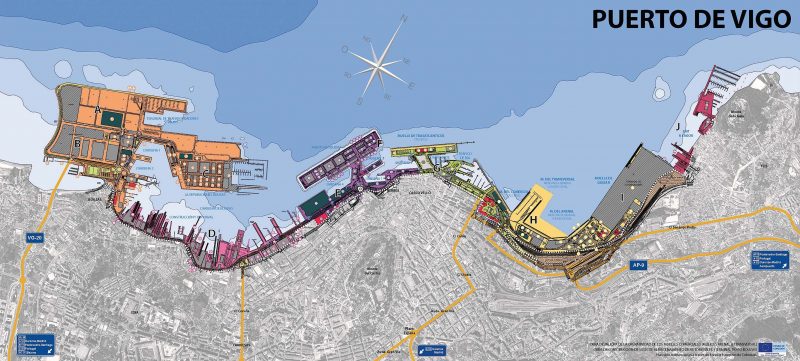

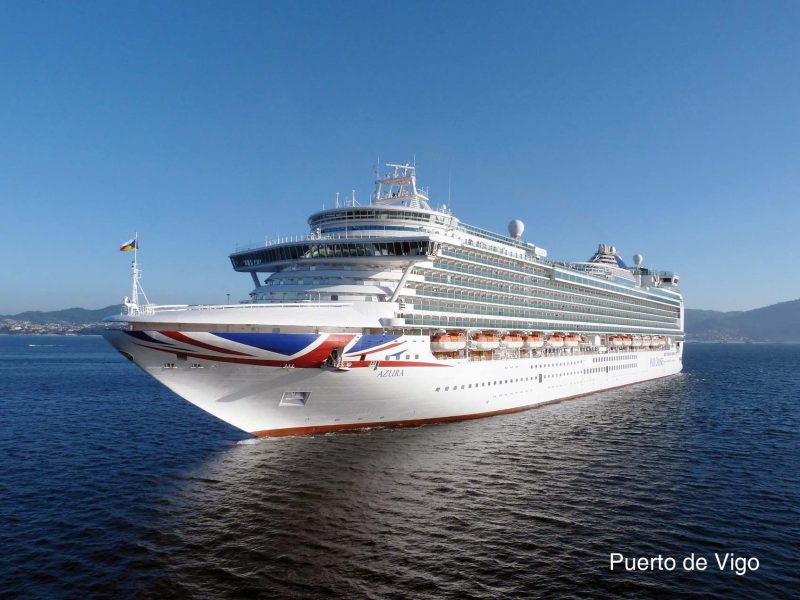




Comments
Sorry, comments are closed for this item